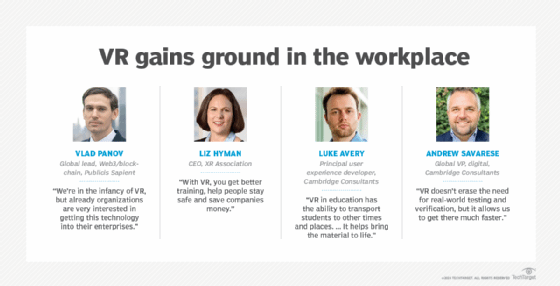Today's virtual reality use cases and industry applications
Applications of virtual reality in business are growing, as a range of industries finds valuable uses for this rapidly evolving technology.
Analysts are bullish on virtual reality for 2024, with multiple market reports predicting a significant bump in sales for both augmented reality and VR headsets in the upcoming months and beyond.
Virtual reality is a digital 3D environment generated by computers using computer graphics, 360-degree video and audio in real and simulated scenarios. The environment surrounds users and allows them to interact with it via specially designed helmets or goggles in ways that approximate reality.
Although consumer products such as Apple's Vision Pro have been generating the most buzz so far this year, VR experts interviewed here pointed to even stronger growth in enterprise use of this technology.
In fact, the use of virtual reality is becoming mainstream in more business verticals, including manufacturing, healthcare and education, as organizations see the workplace benefits of using VR in myriad use cases.
"We're in the infancy of VR, but already organizations are very interested in getting this technology into their enterprises," said Vlad Panov, the global lead for Publicis Sapient's web3/blockchain and metaverse practices.
Here are 10 business areas and how they're using VR, all of which illustrate the technology's impact and its ability to deliver strong returns on investment.
1. Manufacturing, utilities and heavy industry
Organizations in manufacturing, utilities and heavy industry such as mining use VR to train their workers -- one of the most prolific uses of VR in the enterprise, said Liz Hyman, CEO of the XR Association, a nonprofit organization for the extended reality (XR) industry, which includes AR, VR, mixed reality and future immersive technology.
There are good reasons for VR's increasing use for training new and existing employees, she and others said.
First, studies show that workers who train using virtual reality generally learn faster and retain more knowledge than many other forms of learning, such as watching videos or reading manuals.
Furthermore, VR allows workers to repeat and practice any or all parts of their training until they perfect the material, something that either can't be done in the real world or can't be done at a reasonable cost, said Nicholas Napp, a senior member of the Institute of Electrical and Electronics Engineers (IEEE) and co-founder of Xmark Labs.
Additionally, the use of VR allows workers to be trained in an environment that doesn't impact existing operations, such as a factory assembly line or an oil rig where having trainees learn can either create risks or slow down work.
"With VR, you get better training, help people stay safe and save companies money," Hyman added.

2. Aviation, military, space exploration, other high-risk industries
Virtual reality offers individuals the ability to experience and train for situations that are either impossible to replicate in the real world or would be exceedingly dangerous to replicate, Panov said, adding that the simulation of dangerous scenarios to drill for responses shows the high value of VR.
Pilots use VR to practice their responses in emergency situations. Soldiers use VR to experience simulated battles. Astronauts use VR to control robots. And emergency personnel test how to respond to catastrophes so they'll be well-equipped to handle real-world scenarios should they arise.
"These are situations where you don't want to put people in [real-world scenarios] just for training, even though there is clearly a big benefit for people experiencing the situation so they know how to respond in case something happens," said Luke Avery, principal user experience developer with Cambridge Consultants. "So, allowing them to run through these things in VR means if they do encounter those situations, they have some previous experiences."
3. Healthcare
Virtual reality is becoming an important technology in the healthcare industry, too, with VR being used more often by both clinicians and patients.
Clinicians use VR to learn, train, practice and collaborate, Avery said. They use VR to run through complex or unusual operations to help limit the risks to the patients undergoing the procedures; to hone their skills by practicing care over and over again -- something they can't do on real people; and they confer and collaborate with specialists, helping to ensure expertise is available to all who need it despite real-world physical distances.
Panov said patients also are benefiting from the technology, as VR is being used as part of therapy to treat certain conditions such as phobias, depression and post-traumatic stress disorder.
4. Fitness and well-being
VR is similarly aiding the fitness and well-being space, said Eric Abbruzzese, who as a research director with ABI Research leads the firm's study of AR, VR and MR.
Abbruzzese explained that VR can help relieve loneliness, sharpen mental acuity and reduce isolation by providing therapeutic programming, engaging content and interactions with others that may not be easily scheduled in the real world.
Furthermore, the technology is also making its way into the fitness realm, Hyman said. VR is being used to offer people more entertaining and enticing workout options; they can opt to work out as if they're among ancient ruins, for example, or they can easily gamify their exercise routines.
5. Education
Education is another industry where VR is making inroads, Avery said.
Similar to its use for employee training, VR in education is delivering content that engages students more fully and, thus, helps them better absorb and understand material.
VR in education has the ability to transport students to other times and places -- something that would be either cost prohibitive or downright impossible to do in the real world, Avery said. "It helps bring the material to life."
Consider the difference, for instance, between looking at a picture of Roman ruins versus visiting a digital version of an ancient Roman market full of people and commerce at the height of the Roman empire.
And like its use in training, VR allows students to repeat lessons and focus on specific areas where they need the most review until they perfect the information or skill.
6. Entertainment and tourism
Consumer adoption of VR headsets has yet to fully take off, but Abbruzzese said his firm predicts consumer demand for these devices is climbing. And with that increase, Abbruzzese said more organizations will see market opportunities to create content for consumer entertainment.
He said consumers can expect a growing volume of VR games, other forms of entertainment, tourism content and virtual travel to hit the market in coming years as more people get VR headsets and seek out those experiences.
7. Architecture, construction, real estate, design
Architects, builders, real estate agents, community planners, and others in the planning and design industries also benefit from the use of virtual reality.
IEEE's Napp pointed to the use of VR in urban planning as an example, saying VR could combine maps of the urbanscape, transit information and data about how people move to give planners a realistic in-the-moment understanding of how they all fit together.
"Being able to actually visualize the flow is very powerful," he said.
He said he also saw how one company used VR to give investors a tour of a proposed new building, which provided a more tangible look at the planned project than 2D blueprints.
And he said he knows an architect firm that had its employees use VR to move through a design as if they were in wheelchairs so they could test whether they had built a truly accessible building -- something that they couldn't experience using traditional design software.
8. Product design and development in multiple industries
Another big use case for VR is product design and development, said Andrew Savarese, global vice president, digital surgery at Cambridge Consultants.
It's a use case that is seen in numerous industries, including automotive and consumer goods.
Savarese said VR allows teams to explore multiple designs of the same product or to explore multiple products, with those teams able to interact and test each item in the virtual space. They then can determine which one would be the best to build.
VR allows this exploration and testing to happen at a fraction of the time and cost it would take to do in the real world with real-world prototypes, Savarese added.
His firm has tested proposed medical devices in this manner, using VR to put clinicians in hospital rooms to ascertain whether those devices would work well. Savarese said he used a similar process to develop a new coffee pot.
"We're able to look at the human interactions with the [items] and take that into account. That gives us better insights earlier in the [development] process," he said, adding that "VR doesn't erase the need for real-world testing and verification, but it allows us to get there much faster."
9. Retail
Although augmented reality has made a stronger showing in the retail space (with applications allowing shoppers to digitally overlay items onto themselves to see how they might look in real life or digitally place items into their homes to see if they'd fit), experts said VR is starting to be used by more retailers.
Panov said VR allows retailers to give shoppers an experience that outpaces online shopping as it exists today, with the ability to pick up objects and move around them to get a nearly real sense of how they would examine those items in the real world.
10. Recruitment
Organizations aren't only using VR to train new hires and existing workers; Hyman said she has seen some use VR to help recruit people to their company or to certain professions by giving those individuals a realistic sense of what certain jobs entail.
"It allows both potential employees and the employer to gauge a particular interest and ability in a specific job track," she explained, noting that she saw one HVAC company invest in VR training to entice people to the field and saw applications for jobs increase as a result. "It's not only a great tool for how to learn but a signal to young people that this is a career track that's interesting and up to date with technology."
Mary K. Pratt is an award-winning freelance journalist with a focus on covering enterprise IT and cybersecurity management.








